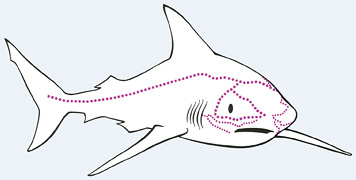
|
||||||||||||
|
|
|
Sharks
More people are killed every year by bees, elephants, dogs, lightning bolts, and pigs than by sharks Humans kill 100 million sharks a
year
|
- shark fins for a tasteless bowl of soup
- shark teeth for jewelry
- shark jaws for tourist souvenirs
- shark skin for leather wallets/belts
- shark cartilage capsules and powders for phony medicinal cures
- shark liver oil for cosmetics/skin care products
Sharks are considered good bio-indicators of the health of the ocean, and despite their importance in the marine food-chain they remain a low conservation priority.
Over 100 million sharks are killed annually. Partly because of their fins for shark fish fin soup, as bycatch in up to 40 miles long drift nets of enormous fishing fleets, for medically completely ineffective cartilage powder or by the destruction of their habitats.
With 90% of the world's large shark populations already wiped out, sharks are being depleted faster than they can reproduce. This threatens the stability of marine ecosystems around the world. Sharks are vitally important apex predators. They have shaped marine life in the oceans for over 400 million years and are essential to the health of the planet, and ultimately to the survival of mankind.

In the 1970s, his fictional best-seller, JAWS (which Spielberg made into a blockbuster movie) generated a fear of sharks simply because so little was known about them. By the 1980s, that fear had given away to curiosity, resulting in an unprecedented amount research on sharks.And so, in the 1990s, as sharks became target species for Asian markets, scientific data were available to combat threats to sharks — data which existed because of the fascination in sharks that Peter had sparked. Throughout his life, Peter remained a spokesman for sharks and an ardent shark conservationist. This award is given to honor Peter’s memory and ensure continuation of his conservation efforts on behalf of sharks.
Jaws is a 1975 American thriller film directed by Steven Spielberg and based on the late Peter Benchley's novel of the same name.-When a gigantic great white shark begins to menace the small island community of Amity, a police chief, a marine scientist and grizzled fisherman set out to stop it.
"I couldn't write "Jaws" today. The extensive new knowledge of sharks would make it impossible for me to create, in good conscience, a villain of the magnitude and malignity of the original."

Peter Benchley
"But sharks are more often victims than villains. Know one knows precisely how many sharks are killed every year, but a widely excepted estimate is 100 million. In other words, for every recorded attack on a human being, more than four million sharks are destroyed by human beings. Much of the killing is wanton and wasteful. Thousands of sharks die in nets or on longlines and are discarded by fisheries because they aren't needed. Others are massacred because a few body parts are worth a fistful of dollars, as with "finning", in which a shark is caught, its fins sliced off to be sold to make soup in Asia, and the still-living animal is tossed back into the sea to die."-Peter Benchley, Author of "Jaws"
The Brutal Business of Shark Finning


Human beings are skilled at justification. Every year humans slaughter over 100 million sharks yet we depict them as vicious and blood-thirsty killers.
No more than 12 people a year are killed by sharks worldwide. In fact is more dangerous to play golf than to swim in the ocean with sharks. More golfers are struck by lightning and killed each year than the total number of shark fatalities. Many more humans are struck and killed by boats every year than are attacked by sharks.

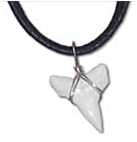


Yes, we also kill them for their teeth and jaws, and we kill them for shark leather for shoes and belts. We slaughter them for shark liver oil and for shark cartilage for pseudo cancer cures. Sharks are used in cosmetics, skin care products and in medicines.
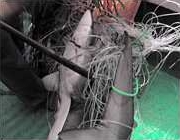 We
kill sharks because of our fear of them, for food, for sport, and most
disturbing of all - so that some of us can make a tasteless, expensive soup to
impress our family and friends.
We
kill sharks because of our fear of them, for food, for sport, and most
disturbing of all - so that some of us can make a tasteless, expensive soup to
impress our family and friends.
It is the mass slaughter of sharks on longlines and in nets for the sole purpose of taking their fins that is responsible for the incredible diminishment of shark populations around the world.
The fins are highly prized. The fishermen catch the sharks and slice off the fins, unmindful whether the shark is alive or not. The bodies, most of them still alive, are tossed back into the sea to bleed to death or to be attacked by other sharks or fish.
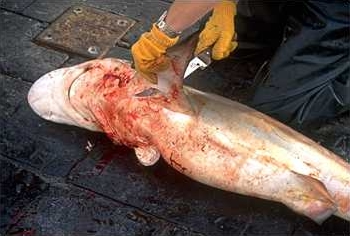
Sharks are Endangered
Over 8,000 tons of shark fins are processed each year. The fins only amount to 4% of a shark's bodyweight. This means that some 200,000 tons of shark are thrown back into the sea and discarded.
Already 18 species of sharks have been listed as endangered by the International Union for the Conservation of Nature (IUCN).
Shark Fin Soup - for what?

 The
fins are dried, stacked, and sold, mostly illegally. The buyers extract the
collagen fibers, clean them, and process them into "shark fin soup."
The
fins are dried, stacked, and sold, mostly illegally. The buyers extract the
collagen fibers, clean them, and process them into "shark fin soup."
This soup has no flavor and absolutely no nutritional value. It is a dish served only for prestige purposes, selling for anywhere from US$50.00 to US$400.00 per bowl.
The demand for shark fin soup has developed since 1985 and coincides with the rapid growth of the Chinese economy. The demand from China is for staggering amounts of shark fins. As a result, the oceans are literally being scoured clean of sharks. Poachers are invading national marine parks like the Galapagos Islands in Ecuador and Cocos Island in Costa Rica to catch sharks.
Forget the fictional fear spawned by Steven Spielberg's ridiculous film Jaws. The oceans are no longer safe for sharks. And the horror is that we don't just kill them, we hack off their limbs and toss their mutilated bodies back into the sea to die an agonizing and horrific death.
Chinese Basketball Hero, Yao Ming Acts to Saves the Sharks
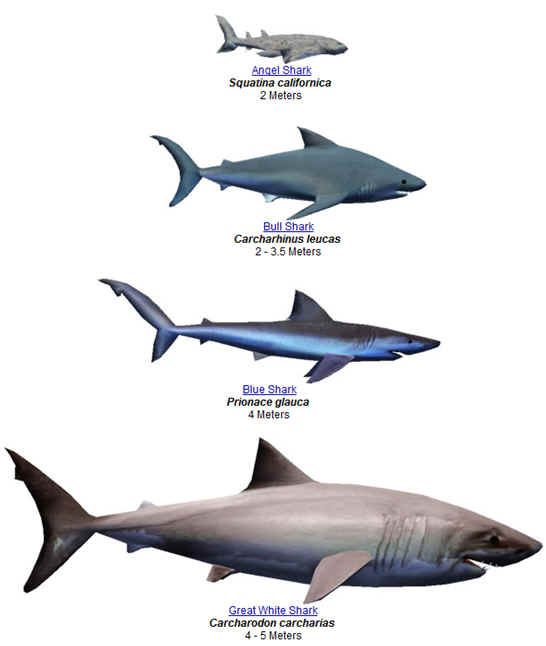
Sharks belong to the class Chondrichthyes, a group which also includes rays, skates and chimeras. Unlike other vertebrates, sharks have a skeleton made of cartilage rather than bone.
Only about 800 species of cartilaginous fish are known to exist compared to over 20,000 known species of bony fishes.
Sharks differ from the more common bony fishes in several ways. Besides having no bones, sharks and their relatives do not have the overlapping scales that cover many bony fish. Nor do they have a swim bladder, the air-filled balloon-like organ that keeps most fish upright. Sharks have gill slits but no gill-cover, which is common to the bony fish.
Sharks vary greatly in size from the enormous 40-foot-long whale shark to tiny two-to three foot dogfish and angel sharks. Despite its huge size, the whale shark is not an active predator. It feeds rather passively by swimming with its mouth open to collect plankton and small fish.
Most sharks are active predators and eat primarily fish, although the great white shark will also prey upon seals, sea lions and other marine mammals. Some sharks eat bottom-dwelling animals such as crabs, and others scavenge for dead animals. Some sharks even eat trash as indicated by the tin cans and boots found in sharks' stomachs. Because they have no swim bladder to keep them buoyant, sharks sink when not swimming.
Sharks' bodies are heavier than water. The nurse shark, skates and rays have adapted to resting on the bottom, but most sharks are constantly on the move. Moving forward with their mouths open is how sharks move water across their gills for breathing. Most cannot stop for long or move backwards as can bony fishes.
Sharks(superorder Selachimorpha) are a type of fish with a full cartilaginous skeleton and a highly streamlined body. The earliest known sharks date from more than 420 million years ago, before the time of the dinosaurs.
Since that time, sharks have diversified into 440 species, ranging in size from the small dwarf lanternshark, Etmopterus perryi, a deep sea species of only 17 centimetres (7 in) in length, to the whale shark, Rhincodon typus, the largest fish, which reaches approximately 12 metres (39 ft) and which feeds only on plankton, squid, and small fish through filter feeding. Sharks are found in all seas and are common down to depths of 2,000 metres (6,600 ft). They generally do not live in freshwater, with a few exceptions such as the bull shark and the river shark which can live both in seawater and freshwater. They respire with the use of five to seven gill slits. Sharks have a covering of dermal denticles that protect their skin from damage and parasites and improve fluid dynamics so the shark can move faster. They have several sets of replaceable teeth.
Well-known species such as the great white and the hammerhead are apex predators at the top of the underwater food chain. Their extraordinary skills as predators fascinate and frighten humans, even as their survival is under serious threat from fishing and other human activities.
CLASS - CHONDRICHTHYES
1. Chondrichthyes are fish with the following characteristics: a skeleton made of cartilage, jaws, paired fins, and paired nostrils. Granules of calcium carbonate on the outside of the cartilage add strength. The mosaic granule pattern is unique to chondrichthyan fishes. These fishes also lack a swim bladder found in most bony fishes. Unlike these lookdown fish (Selene vomer), sharks lack hard bones. Red blood cells in sharks are therefore produced in the kidneys and a special organ called an epigonal. White blood cells are created in the spleen and spiral valve within the intestine.
2. Chondrichthyes are further divided into two subclasses: Holocephali and Elasmobrachii. • The subclass Holocephali includes fishes known as chimaeras. They are characterized by the fusion of the upper jaw to the cranium (the upper part of the skull that encloses the brain), one pair of external gill openings, and no scales. • The subclass Elasmobranchii includes sharks and batoids. Elasmobranchs are characterized by cylindrical or flattened bodies, five to seven pairs of gill slits, an upper jaw not fused to the cranium, and placoid scales.
SUPERORDERS
1. Elasmobranchs are grouped into two superorders: Batoidea (rays and their relatives) and Selachii (sharks). • Batoids include stingrays, electric rays, skates, guitarfish, and sawfish. They are characterized by a dorso-ventrally flattened body with expanded pectoral fins fused to the head. All batoids have five or six pairs of ventral gill slits. There are four orders and about 470 species of batoids. Of the rays, skates, and sawfishes, rays were the first to develop, beginning in the Late Jurassic Period, some 150 million years ago.
• Selachians include all sharks. They are characterized by a fusiform body and five to seven pairs of lateral gill slits. There are eight orders and about 355 species of selachians.
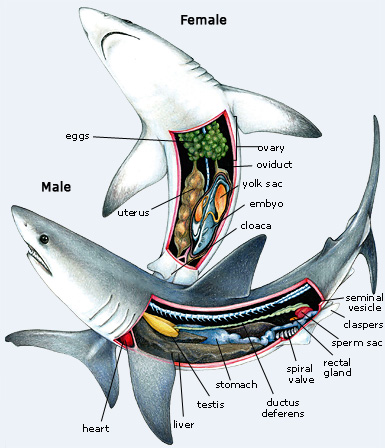
SKELETON
The skeleton of elasmobranchs is made of cartilage. Vestigial ribs give no support.
• The skeleton may be partially calcified to some extent with calcium phosphates and carbonates, particularly in the vertebral column. The calcified cartilage is not a true bone.
• The cartilage of a shark's skeleton may be important in future cancer research. Shark cartilage contains an active ingredient that has been known to inhibit tumor growth. In addition, sharks rarely develop cancer.
• A shark's cranium is a single compact cartilaginous block which encloses the brain, olfactory, and auditory capsules. Jaws are loosely attached to it.
• Without hard bones, red blood cells are produced in the kidneys and a special organ called an epigonal. White blood cells are created in the spleen and spiral valve within the intestine.
MUSCLES
1. Red muscle is aerobic: it needs oxygen to function. This muscle contains myoglobin, an oxygen-carrying pigment. Red muscle functions for cruising.
2. White muscle is anaerobic: it does not need oxygen. White muscle functions for sudden bursts of speed.
DIGESTIVE TRACT
1. The esophagus is short and wide, barely discernible from the stomach. A U-shaped stomach leads to a spiral valve in many species
. 2. A spiral valve is the lower portion of the digestive tract. It is internally twisted or coiled to increase the surface area, which increases nutrient absorption.
3. After the spiral valve, the digestive tract leads to the rectum and to the cloaca. The cloaca is a common opening for the urinary, digestive, and reproductive systems.
4. If a shark eats something terribly upsetting, some species can force their stomach out through their mouth and into the water to empty it out.
5. Some sharks have highly specialized stomachs. If threatened, the balloon shark (Cephaloscyllium sufflans) can rapidly inflate its stomach with air or water just like pufferfish and porcupinefish
CIRCULATORY SYSTEM
1. A shark's heart is a two-chambered S-shaped tube, small in proportion to body size. Blood flows from the heart to the gills and then to body tissues.
2. Fast-swimming sharks, such as great whites and makos, have a body temperature that can be quite a bit higher than the surrounding water (up to 8°C or 14.4°F higher). The heat is due to the modified circulatory system associated with the red muscle.
• As red muscle functions, it generates heat. Muscle-generated heat warms the blood circulating through the red muscle, which then travels back to the heart through veins. Thus, blood returning to the heart from the muscle is warmer than blood traveling from the heart to the muscle.
• Due to the nearness of arteries and veins, heat passes from warmer veins to cooler arteries within the shark's body, rather than dissipating to the cooler environment. This modified circulatory system retains heat in the red muscles.
3. Sharks have a low blood pressure. The walls of the pericardium (the membranous sacs that enclose the heart) are rigid, creating a suction within the pericardium to maintain the flow of blood. To circulate blood throughout their bodies, many sharks must swim continuously.
GILL & RESPIRATION
1. Water enters the gill chambers through the mouth or spiracles and exits through the gill slits. In the past, it was assumed that all sharks must swim to move water into their mouth and over their gills to respire. We now know that sharks can respire by pumping water over their gills by opening and closing their mouths. However, many sharks do have to swim continuously: due to their low blood pressure, muscular contractions are needed to circulate their blood.
2. Blood in the gill filaments absorbs oxygen from the incoming water.
3. Gill rakers, cartilaginous projections on the gill support structure, protect the delicate gill filaments from particles in the water that might damage them.
4. In species where they are present, spiracles provide oxygenated blood directly to the eye and brain through a separate blood vessel which is reduced or absent in active, fast-swimming sharks.
Hearing
• Sharks have only an inner ear, which consists of three chambers and an ear stone called an otolith. A shark's inner ear detects sound, acceleration, and gravity
. • Sharks use sound to locate food.
° Sound is often the first sense a shark relies on to detect prey. ° Under water, sound travels farther and approximately 4.5 times faster than on land.
° Sharks are attracted to low-frequency pulsed sounds, similar to those wounded or ill prey would emit. Most attractive sounds are in the frequency range of 25 to 100 Hz. Some sharks are attracted to sound sources from distances as great as 250 m (820 ft.).
2. Lateral line
The lateral line system is a series of fluid-filled canals just below the skin of the head and along the sides of the body. The canal is open to the surrounding water through tiny pores.
• The lateral line canals contain a number of sensory cells called neuromasts. Tiny hair-like structures on the neuromasts project out into the canal. Water movement created by turbulence, currents, or vibrations displaces these hair-like projections and stimulates the neuromasts. This stimulation triggers a nerve impulse to the brain.
° Like the ear, the lateral line senses low-frequency vibrations. It functions mainly in distance perception and detecting low-frequency vibrations and directional water flow.
EYESIGHT
1. Sharks have a basic vertebrate eye, but it is laterally compressed. The lens is large and spherical.
2. Although the threshold of a shark's visual acuity has not been demonstrated, it is apparent that they are well-suited for seeing in dim light. Their eyes are particularly sensitive to moving objects.
• Sharks have a large proportion of rods, which are highly sensitive to changes in light intensity, making sharks sensitive to contrasts of light and shadow.
• The eye has a layer of reflecting plates called tapetum lucidum behind the retina. These plates act as mirrors to reflect light back through the retina a second time. The tapetum lucidum of a shark is twice as effective as that of a cat. In bright light, pigments temporarily cover and block the tapetum to prevent eye damage from intense light.
3. Unlike those of other fishes, a shark's pupil can dilate and contract. A shark's pupil can dilate and contract
. 4. Cone cells are present, indicating that sharks may have some sort of color vision.
5. In clear water, a shark's vision is effective at a distance up to about 15 m (50 ft.).
6. Some sharks are extremely sensitive to direct sunlight. Puffadder shysharks (Haploblepharus edwardsii) curl their tails back to cover their eyes if they are pulled out of the water.
TASTE
1. Sharks and batoids have taste buds inside their mouths. These taste buds have not been studied extensively. Taste may be responsible for a shark's final acceptance or rejection of prey items. Some sharks seem to prefer certain foods over others and have been known to spit out things that may have had an unpleasant taste.
SMELL
1. Paired external nostrils with an incurrent and an excurrent opening lead to ventral olfactory organs (organs which function in smelling). Olfactory organs are blind sacs which are not connected with the mouth. Sharks have often been described as "swimming noses" because of their excellent sense of smell.
2. Sharks have an acute sense of smell. They are well-known for their ability to detect minute quantities of substances such as blood in the water. Sharks can detect a concentration as low as one part per billion of some chemicals, such as certain amino acids. A shark's sense of smell functions up to hundreds of meters away from a source.
3. Some sharks have "whiskers" or barbels near the nostril area. The mandarin dogfish (Cirrhigaleus barbifer) trails its long barbels on the ocean floor. Presumably the barbels enhance tactile or chemoreceptors. This feature can be found on other species such as sawsharks (family Pristiophoridae) and nurse sharks (family Ginglymostomatidae).
AMPULLAE OF LORENZINI
1. The ampullae of Lorenzini form a complex and extensive sensory system around a shark's head.
2. External pores cover the surface of a shark's head. Each pore leads to a jelly-filled canal that leads to a membranous sac called an ampulla. In the wall of the ampulla are sensory cells innervated by several nerve fibers.
3. The ampullae detect weak electrical fields at short ranges. All living organisms produce electrical fields.
4. Ampullae of Lorenzini are effective only within inches, as they sense bioelectric fields in the final stages of prey capture.
5. Mainly considered electroreceptors, it is possible that the ampullae of Lorenzini may also detect temperature, salinity, changes in water pressure, mechanical stimuli, and magnetic fields.
SENSORY PITS
1. A sensory pit is formed by the overlapping of two enlarged placoid scales guarding a slight depression in the skin. At the bottom of the pit is a sensory papilla: a small cluster of sensory cells that resemble a taste bud.
2. Sensory pits are distributed in large numbers on the back, flank, and lower jaw. • The precise function of sensory pits has not been determined. They are most likely sense organs that are stimulated by physical factors such as water current.
SHARK ATTACKS
More people are killed every year by bees, elephants, dogs, lightning bolts, and pigs than by sharks
1. Only 32 species of sharks have been identified with attacks on humans or boats. These species have three features in common: they prey on fish or marine mammals, grow to a large size, and frequent warmer coastal waters where swimmers are apt to be.
2. In 1958, the U. S. Office of Naval Research and the American Institute of Biological Sciences set up the Shark Research Panel - a union of scientists that gathered documentation on shark attacks and compiled the information into the Shark Attack File. The Shark Research Panel documented the following:
• Humans become prey by accident. Most shark attacks involved people handling hooked or snared sharks or spearfishermen handling wounded fish. Through sight or sound, a shark may confuse swimmers or divers for prey.
• Sharks may also attack from a territorial drive, with no intention to feed. A characteristic swimming pattern called agonistic display usually precedes attacks out of territoriality. The shark shakes its head and swims erratically with a hunched back, pectoral fins pointing down, and snout pointing up.
3. An analysis of 1,000 recent shark attacks world-wide showed that well over 50% of the attacks were not feeding-related.
4. Up to 60% of shark attack injuries are slashes of the upper jaw teeth. This behavior is typical of courtship advances by some male sharks.
5. Sharks may also injure victims by bumping them vigorously, but mostly sharks move in cautiously when attacking.
6. A great white shark rushes towards its prey, attacking from beneath and behind. These sharks rely on stealth and surprise to prey on seals, sea lions, and other marine mammals.
• After a great white shark bites its victim, it swims a short distance away, waiting for its victim to bleed to death.
• Great white shark populations may be increasing along the coasts of California and Oregon due to increasing populations of seals and sea lions. Marine mammal populations are increasing as a result of federal protection. Populations of predators naturally increase as food becomes more readily available.
• Swimmers and skindivers at the surface are prone to attack more than scuba divers in the water. At the surface, a swimmer's or diver's silhouette resembles that of a seal. Great white sharks may not be able to make the distinction.
California has one of the highest great white shark attack rates in the world, yet fatalities average only one every eight years. Most humans survive attacks by great white sharks and sharks in general.
• In False Bay, South Africa, great white sharks attack more boats in this one area than in all other places in the world combined. No one understands why this phenomenon occurs at False Bay.
• Great whites are usually listed as the most dangerous shark for attacks on humans. Strangely, 80% of reported attacks are in tropical waters where great whites are rare. The tropics are home to large, potentially dangerous species such as bull, tiger, and mako sharks . It is possible the great white shark is misidentified in many attacks.
For More Information Visit The Following Websites
Credit: Sea World, Wild Aid, Sea Shepherd Conservation Organization, Shark Research Institute
